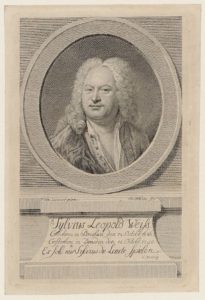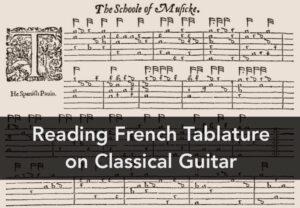Sylvius Leopold Weiss (1687–1750) lute works arranged as PDF sheet music for classical guitar. Quality sheet music with free video performances to prove the beauty and playability of the music. The music of Sylvius Leopold Weiss is some of the most beautiful music of the Baroque era. The galant style features smooth flowing musical lines along with Baroque era textures and ideas. Although there are many difficulties in arranging 13-course lute music on the 6-string guitar, guitarists will continue to pursue the music of Weiss due to its beauty and historical connection to plucked instruments. I currently have three works by Weiss with sheet music and videos. Sonata IX in C Major – Prelude, Allemande, Courante, Bourée, Sarabande, Menuet 1 & 2, Presto (Dresden Manuscript – WeissSW37.1 à 8 Ms. Dresde D-Dl2841.). Mademoiselle Tiroloise (SW28) in D Major from the London Manuscript. The Tombeau sur la Mort de M. Comte d’Logy is one his finest works and very popular arrangement for guitar.
My Sheet Music Editions
- Weiss: Mademoiselle Tiroloise (SW28) – Grade 7
- Weiss: Tombeau (Comte d’Logy), Grade 9
- Sonata IX in C Major (Dresden) – Prelude, Allemande, Courante, Bouree, Sarabande, Menuets, Presto.
Here are some videos of the above editions of Weiss I’ve made.
Weiss Biography and Context
More on Weiss from this Naxos album by Tim Crawford. The lute recordings of Robert Barto are some of my favourite recordings of this music and beautifully recorded and performed. You can also check out this wonderfully informative site on Weiss that explores the documents and works.
By the end of the seventeenth century the lute had lost much of its traditional high esteem in the musical life of France, Italy and England. French lutenists had largely led the way in lute playing since around 1600, and had developed special tunings and a famous precieux style of performance which was highly admired throughout Europe. Many young amateur and professional lutenists from Austria, Silesia, Bohemia and Germany actually studied with, or at least were greatly influenced by, the great French luthistes such as the Gaultiers, Ennemond le vieux and Denis, François Dufault, Charles Mouton and Jacques Gallot. To the conventional French Suite form, in which a sequence of dances, often preceded by a quasi-improvised prelude, was performed in a more-or-less fixed order, they added certain aspects of local colour and of course their own compositional character. Freed from the restraints of Parisian conventional bon gout, lute music evolved steadily in the East of Europe, while in France it suffered a severe decline to the point where the instrument was hardly to be heard at all in Paris during the 1720s.
Mention of amateur lutenists as pupils of the great French players should not imply that these dilettantes were not sometime players of great distinction. They had in common, however, one important social distinction: almost without exception they were members of the aristocracy. Playing the lute or another instrument, along with fencing, horsemanship, dancing and etiquette, still formed an essential part of many a young nobleman’s education. The principal, and most expensive, musical diversion for the German aristocracy was, of course, Italian opera, which, as always, consumed vast resources, but at the same time provided employment for hundreds of Italian composers, poets, singers, dancers and stage designers. The musical effect on lute music was to shift the emphasis of composition and performance away from the restrained and microscopically subtle exploitation of the harmonic effect of small melodic motifs (the style precieux) towards a legato cantabile line over a clearly-defined bass, in an instrumental evocation of Italian bel canto.
A true cantabile is not easy to achieve on a plucked-string instrument, whereas it is very natural to the violin, for example. Certain technical features of the lute of the time — especially the sympathetic resonance of its many bass strings — were especially exploited to this effect by German lutenists during the early eighteenth century. The greatest of these, especially praised for his cantabile playing, was Silvius Leopold Weiss, born in Breslau, capital of Silesia, (now Wroclaw, Poland) in 1686. He studied lute playing with his father from the age of ten, and within the next decade was in the service of the local Prince-Bishop as a lutenist. Soon he moved to Düsseldorf where he was engaged by the Palatine Court, as were his father and his brother, both of them fine lutenists. In 1708 he was appointed one of a number of musicians accompanying Prince Aleksander Sobieski, the son of the deposed Queen of Poland, who went to join his mother in exile in Rome. Weiss stayed in Italy until 1714, when Prince Aleksander died after a long consumptive illness.
Doubtless the first-hand experience of Italian musical life, in particular performances by Corelli and the Scarlattis, Alessandro and his son Domenico, had a profound effect on the music of Weiss himself. A handful of pieces has survived from prior to the Italian period, and we have a few more probably composed there; both suggest that his compositional technique was already remarkably sound, as was that of the young Handel when he had arrived in Italy a few years before. It is not known who taught Weiss composition, but his oeuvre of over six hundred solo pieces and many works for the lute and various chamber ensembles (all tragically incomplete) show that in this respect he towers above all the other lutenists of his age. Indeed, but for the fact that he never worked in any genre than those idiomatic to the lute (as far as we know), he would probably be regarded as a significant German composer to be ranked not far below J. S. Bach himself.
After a few years in service at Cassel and then as a traveling virtuoso, Weiss obtained a lucrative post in 1718 at the magnificent Dresden court, where the Elector, August “the Strong” (also, ironically, King of Poland, and thus the direct rival to his former employers, the Sobieskis), had established the leading orchestra in Europe. Weiss stayed at Dresden until his death in 1750, performing for the Elector, his family and for visiting dignitaries, and taking his place in the opera orchestra as one of the principal accompanists. Such was the value attached to his playing (and, we might suppose, to his compositions) that he eventually became the highest-paid instrumentalist at Dresden ; not even the considerable financial inducements offered by the Viennese court could tempt him away.
From this Naxos album: Sylvius Leopold Weiss (1686-1750) Sonatas for Lute, Vol. 1.





